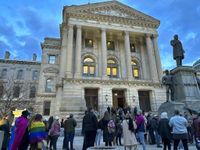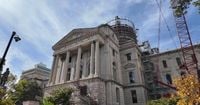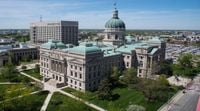On Monday, October 27, 2025, Indiana politics took center stage as Governor Mike Braun officially called for a special legislative session, set to begin November 3, with the fate of the state’s congressional districts hanging in the balance. The move, announced via a formal proclamation, is widely seen as a response to mounting pressure from the White House and could dramatically reshape Indiana’s representation in the U.S. House of Representatives.
The usually staid Bloomington city council chambers were packed to the rafters that evening, as State Representative Matt Pierce—who represents District 61, encompassing most of Bloomington—hosted a community town hall. The crowd spilled into the balcony, a clear sign of the issue’s significance. Pierce, a Democrat, is facing a primary challenge from Lilliana Young, but on this night, all eyes were on the looming redistricting battle and its potential to upend Indiana’s political landscape.
Earlier that day, Governor Braun’s proclamation had set the state abuzz. The special session’s stated goals: redrawing congressional district boundaries and updating Indiana’s tax code to align with recent federal changes under the so-called Big Beautiful Bill. In his statement, Braun declared, “I am calling a special legislative session to protect Hoosiers from efforts in other states that seek to diminish their voice in Washington and ensure their representation in Congress is fair.” According to Axios, he also emphasized the need for “stability and certainty for taxpayers and tax preparers for 2026 filings.”
But the subtext was unmistakable. As reported by The B Square Bulletin and Axios, the governor’s move is widely interpreted as yielding to pressure from President Donald Trump and Vice President J.D. Vance, both of whom have made clear their desire to see Indiana’s congressional map redrawn mid-decade—well before the next scheduled redistricting after the decennial census. Trump’s aim, according to multiple sources, is to boost Republican control from seven of Indiana’s nine congressional seats to a clean sweep of all nine, thus bolstering the GOP’s tenuous majority in the U.S. House ahead of the 2026 elections.
This is no small matter. Redistricting has traditionally been a once-a-decade affair, following the release of new Census data. Yet, as Axios notes, Indiana joins a growing list of states—including Texas—that are pursuing mid-cycle redistricting in 2025 to shore up legislative majorities. In Texas, similar efforts have already netted the GOP five additional seats. For Indiana, the targets are clear: the 1st district in northwest Indiana and the 7th district, which covers much of Indianapolis, both currently held by Democrats.
The mechanics of the special session are as fraught as the politics. Republicans hold supermajorities in both chambers of the Indiana General Assembly—70-30 in the House and 40-10 in the Senate. This numerical dominance theoretically gives the GOP the ability to suspend the traditional three-separate-reading-day rule, which requires a bill to be read on three different days before passage. If two-thirds of members agree, a redistricting bill could be passed in a single day. As Pierce explained to the town hall crowd, “They could literally come in, suspend the rules in the morning, vote on the bill in the afternoon, and be home by dinner.”
Yet, there’s a twist. Not all Republicans are on board. Both The B Square Bulletin and Axios report that while House Republicans have the votes to pass redistricting legislation, the Senate remains a stumbling block. Molly Swigart, spokesperson for Senate President Pro Tempore Rodric Bray, told Axios on Monday that “the votes still aren’t there for redistricting.” Pierce interpreted similar signals as coded messages to Washington: “Last week, I was heartened to hear the press person for president pro tem [Rodric] Bray put out the word that ‘We don’t have the votes in the Senate.’ And I really interpreted that as a subtle way of saying to…the people in D.C., ‘It’s like, we’re just not going to do it.’”
Still, the national pressure is intense. As reported by The Indiana Daily Student, Indiana Republican leaders met privately with Trump in late August, and Vice President Vance has visited Indianapolis twice since then to press the case for redistricting. During his October visit, Vance met with Braun and top GOP lawmakers to discuss the “pros and cons” of the move. The message from the White House is clear: deliver a map that guarantees nine Republican seats, or risk falling out of favor ahead of next year’s primaries.
Democrats, for their part, are sounding the alarm. Senate Minority Leader Shelli Yoder, D-Bloomington, minced no words in a statement: “Let’s call it what it is. An orchestrated attack on democracy itself. There is no new census, no court order and no support from the public. There is only political greed and fear.” Yoder also criticized the financial cost to taxpayers, noting that the last special session in 2022 cost $240,000 in per-diem and travel expenses.
Pierce, too, has been blunt in his opposition, describing the effort as a “power grab” and, in a previous statement, asserting, “President Trump and Vice President Vance are so desperate that they are scraping for every seat they can get through gerrymandering. You have to be pretty desperate to decide that having seven of the nine seats in Indiana held by Republicans is not enough.” At the town hall, he told constituents, “I don’t think they really want to do it. I think they know it’s wrong.” He suggested that some Republicans fear retribution from the White House if they oppose redistricting, especially with primary races looming.
So, what’s next? Procedurally, once the special session is called, the governor’s power is limited. As Pierce explained, “the leadership of the House and the Senate get to decide which bills are considered, and how long they’re in session when they meet.” The redistricting bill is expected to originate in the Senate, where GOP support is most uncertain, while the House is likely to focus initially on the tax code update.
Pierce urged the public to make their voices heard, especially by contacting Republican legislators in swing districts and organizing grassroots opposition. “The most effective thing we have to figure out how to do is…network with like-minded people in those Republican districts, because they’re going to respond most to their own constituents.” He added, “Sometimes having just a humongous crowd show up at the state House can cause people to think twice.” But above all, he stressed, “We have to not be afraid. We have to not allow fear to silence us. And so we’ve got to speak out.” The crowd responded with applause.
With the special session set to begin in less than a week, Indiana finds itself at a political crossroads, with the eyes of the nation—and the White House—watching closely. The outcome could reshape not only the state’s congressional delegation, but also the balance of power in Washington for years to come.






